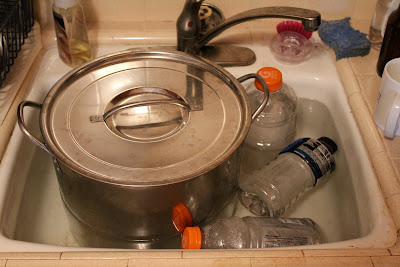Downsizing
In February, I moved in with my girlfriend across town.
It was a relatively big life step that came with some downsizing—in both living space and brewing space. But despite the closer quarters, I was determined to keep my hobby going to the fullest of my ability, while not sacrificing the quality of the beer. I’d do anything for love, but I won’t do that.
The old.
My old apartment had a modern, upgraded kitchen with a lot of counter space, a big sink and a gas stove—all great features for a 4th floor walk-up brewery. The stove was big enough to accommodate my eight-gallon brew kettle, and the sink had a threaded faucet for hooking up an immersion chiller.
I mashed in a cylindrical beverage cooler with a stainless steel mesh braid, ball valve and spigot for drainage.
The cooler rested on a short shelf, letting me lauter into the kettle on the floor.
Next came the typical brewday’s biggest PITA: lifting five gallons of 160+ degree pre-boil wort to the stove top, praying the rivets on my Chinatown kettle would hold.
Once on the stovetop, I’d crank the biggest burner and bring everything to a boil in about 30 minutes. From here I’d add the hops, Whirfloc, and anything else the recipe called for, including the immersion chiller 15 minutes before flame out.
When the boil was over, I’d hook up the immersion chiller to the sink and start running in cold tap water. I’d usually whirlpool the cooling wort with a long sanitized spoon to chill it faster and let the hops and break material settle on the bottom.
Once cool, I’d siphon into an awaiting carboy or bucket fermentor, pitch the yeast, seal it up, and stash it in the hall closet to do its thing.
When bottling day rolled around four weeks later, I’d load new or used-but-clean bottles into the dishwasher for sanitizing. I’d rack the beer off the trub and into a bottling bucket with a few cups of corn sugar solution. Bottles were filled, capped, and stored. It was a beautiful thing.
The new.
The new apartment has a smaller, electric range that won’t fit my eight-gallon kettle, as well as a smaller sink with no threading for chiller hook-up.
I decided rather than going back to extract brewing, I’d brew smaller, three-gallon batches using a method called brew-in-a-bag (BIAB). This let me keep the control and fun of all-grain brewing, while also making it easier and cheaper to brew more often.
I start by heating water in my combination mash tun/boil kettle to strike temperature—usually about 165. I put a metal steamer basket at the bottom of the kettle, followed by a large nylon mesh bag. I dough-in the grains at 1.5 quarts of water per pound and stir until the temperature is even throughout the mash and I can’t see any dough balls.
Then I wrap the whole thing in a towel and let the mash enzymes go to work. I check the temp a few times and give everything a gentle stir. If I need to raise the temperature, I’ll either add boiling water or direct fire the mash tun; the steamer basket at the bottom prevents the bag from scorching and melting.
Once the mash is done, I’ll put the tun on a towel on the floor and slowly lift the grain bag out. I’ll hold the bag just above the surface of the wort for a few seconds and then put it in an aluminum strainer basket to let it drain over the kettle. Next, I do a mini-sparge by sprinkling 170 degree water over the grains in the basket.
After the grains have given what they have to give, I put the kettle back on the stove and start the boil.
When it’s time to cool, I make an ice bath with cold tap water and a handful of frozen Gatorade bottles. Kettle goes in and I stir with a sanitized spoon to whirlpool. Then I’ll cover the kettle and let it rest until the wort temperature gets into the 70’s, changing the ice bath water as needed.
Lastly, I’ll siphon out into the fermentor, pitch the yeast, seal it up, and put everything under the dining room table.
The main difference on bottling day is the lack of a dishwasher; now I spray the inside of the bottles with a sanitzer injector and dry them on a bottle tree. Bottling is no homebrewer’s favorite activity, and this is another area where making smaller batches pays off.
The result.
Like many brewers, I dream of scaling up my system, not scaling it down. But the smaller size of my new setup offers advantage the old system didn’t.
I can brew faster, more affordably, and more often. I can experiment with recipes or techniques without the threat of five less-than-great gallons. I don’t end up with a cases and cases of beer taking up storage space. And my new location means I can walk to the local homebrew store.
I look at this time as a way of finding and fine-tuning recipes that I can eventually brew on a larger scale.
Subscribe to:
Post Comments (Atom)






No comments:
Post a Comment